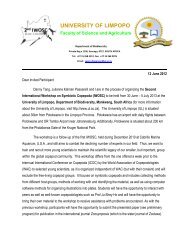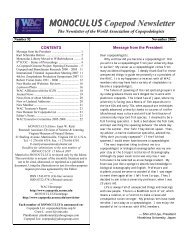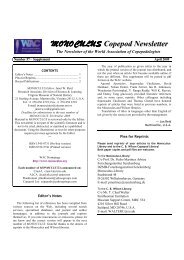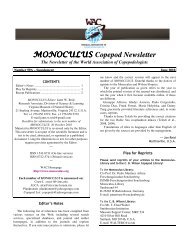International Journal <strong>of</strong> Systematics Evolution andMicrobiology 55(Pt 4):1471-1486.Boxshall, G.A. & J.-L. Justine. 2005. A new genus <strong>of</strong>parasitic copepod (Siphonostomatoida: Caligidae) fromthe razorback scabbardfish, Assurger anzac(Trichiuridae) <strong>of</strong>f New Caledonia. Folia Parasitologica52(4):349-358.Boxshall, G.A. & A. Marchenkov. 2005. A new genus <strong>of</strong>notodelphyid copepod (Crustacea, Copepoda,Cyclopoida) from a compound ascidian host collected inthe Suez Canal. Zoosystema 27(3):483-498.Bradford-Grieve, J.M. 2005. New species <strong>of</strong> benthopelagiccopepod Xantharus (Calanoida: Scolecitrichidae) fromthe upper slope, eastern central New Zealand. NewZealand Journal <strong>of</strong> Marine and Freshwater Research39(4):941-949.Brandl, Z. 2005. Freshwater copepods and rotifers: predatorsand their prey. Hydrobiologia 546(1):475-489.Brenner, W.W. 2005. Holocene environmental history <strong>of</strong> theGotland Basin (Baltic Sea) — a micropalaeontologicalmodel. Palaeogeography, Palaeoclimatology,Palaeoecology 220(4):227-241.Brickle, P., K. MacKenzie & A. Pike. 2005. Parasites <strong>of</strong> thePatagonian toothfish, Dissostichus eleginoides Smitt1898, in different parts <strong>of</strong> the Subantarctic. PolarBiology 28(9):663-671.Brooks, K. 2005. The effects <strong>of</strong> water temperature, salinity,and currents on the survival and distribution <strong>of</strong> theinfective copepodid stage <strong>of</strong> sea lice (Lepeophtheirussalmonis) originating on Atlantic salmon farms in theBroughton Archipelago <strong>of</strong> British Columbia, Canada.Reviews in Fisheries Science 13(3):177-204.Brown, R.J., S.D. Rundle, T.H. Hutchinson, T.D. Williams& M.B. Jones. 2005. A microplate freshwater copepodbioassay for evaluating acute and chronic effects <strong>of</strong>chemicals. Environmental Toxicology and Chemistry24(6):1528-1531.Brucet, S., D. Boix, R. López-Flores, A. Badosa & X.D.Quintana. 2005. Ontogenic changes <strong>of</strong> amino acidcomposition in planktonic crustacean species. MarineBiology 148(1):131-139.Bruno, M.C. & S.A. Perry. 2005. Temporal and spatialvariations in copepod (Crustacea) communities ingroundwater in the Rocky Glades <strong>of</strong> Everglades NationalPark (Florida, USA). Journal <strong>of</strong> Freshwater Ecology20(1):27-36.Bruno, M.C., J.W. Reid & S.A. Perry. 2005. A list andidentification key for the freshwater, free-livingcopepods <strong>of</strong> Florida (U.S.A.). Journal <strong>of</strong> CrustaceanBiology 25(3):384-400.Budy, P., T. Haddix & R. Schneidervin. 2005. Zooplanktonsize selection relative to gill raker spacing in rainbowtrout. Transactions <strong>of</strong> the American Fisheries Society134(5):1228-1235.Buhl-Mortensen, L. & P.B. Mortensen. 2005. Distributionand diversity <strong>of</strong> species associated with deep-sea20gorgonian corals <strong>of</strong>f Atlantic Canada. Pp. 849-879 In:Freiwald, A. & J.M. Roberts (eds.). Cold-water Coralsand Ecosystems. Springer-Verlag, Berlin, Heidelberg.1243 pp.Bulgakov, N.G. & V.N. Maximov. 2005. Determinationanalysis as a tool to investigate the contingencies <strong>of</strong>various components <strong>of</strong> biocenosis. Biology Bulletin32(3):268-275. [Translated from Izvestiya AkademiiNauk, Seriya Biologicheskaya 32(3):327-335.]Bundy, M.H., H.A. Vanderploeg, P.J. Lavrentyev & P.A.Kovalcik. 2005. The importance <strong>of</strong> microzooplanktonversus phytoplankton to copepod populations during latewinter and early spring in Lake Michigan. CanadianJournal <strong>of</strong> Fisheries and Aquatic Sciences / JournalCanadien des Sciences Halieutiques et Aquatiques62(10):2371-2385.Burdick, A. 2005. Out <strong>of</strong> Eden: An Odyssey <strong>of</strong> EcologicalInvasion. Farrar, Straus and Giroux, New York. ISBN-13: 978-0-374-21973-4Burgess, R., J. Sharma, R.S. Carr & P. Montagna. 2005.Assessment <strong>of</strong> storm water outfalls in Corpus ChristiBay, Texas, USA using mei<strong>of</strong>auna. Mei<strong>of</strong>auna Marina14:157-169.Bushula, T., E. A. Pakhomov, S. Kaehler, S. Davis &R.M. Kalin. 2005. Diet and daily ration <strong>of</strong> twonototheniid fish on the shelf <strong>of</strong> the sub-Antarctic PrinceEdward Islands. Polar Biology 28(8):585-593.Buskey, E.J. 2005. Behavioral characteristics <strong>of</strong> copepodsthat affect their suitability as food for larval fishes. Pp.91-106 In: Lee, C.-S., P.J. O’Bryen & N.H. Marcus(eds.). Copepods in Aquaculture. Blackwell Publishing,Oxford, U.K. 352 pp.Butler, H., A. Atkinson & M. Gordon. 2005. Omnivory andpredation impact <strong>of</strong> the calanoid copepod Boeckellapoppei in a maritime Antarctic lake. Polar Biology28(11):815-821.Butterworth, K.G., J.D. Ronquillo & R.S. McKinley. 2005.Simplified illustrated sea lice identification guide forLepeophtheirus salmonis and Caligus clemensi in BritishColumbia, Canada. Aquaculture <strong>Association</strong> <strong>of</strong> CanadaSpecial Publication 9:101-103.Byström, P. & J. Andersson. 2005. Size-dependent foragingcapacities and intercohort competition in an ontogeneticomnivore (Arctic char). Oikos 110(3):523-536.Cáceres-Martínez, C., J. Chávez-Villalba & L. Garduño-Méndez. 2005. First record <strong>of</strong> Pseudomyicola spinosus inArgopecten ventricosus in Baja California, Mexico.Journal <strong>of</strong> Invertebrate Pathology 89(2):95-100.Calles, A., M. Vincx, P. Cornejo & J. Calderón. 2005.Patterns <strong>of</strong> mei<strong>of</strong>auna (especially nematodes) in physicaldisturbed Ecuadorian sandy beaches. Mei<strong>of</strong>auna Marina14:121-129.Calliari, D. & P. Tiselius. 2005. Feeding and reproduction ina small calanoid copepod: Acartia clausi can compensatequality with quantity. Marine Ecology Progress Series298:241-250.
Capitanio, F.L., M. Pájaro & G.B. Esnal. 2005.Appendicularians: an important food supply for theArgentine anchovy Engraulis anchoita in coastal waters.Journal <strong>of</strong> Applied Ichthyology 21(5):414-419.Caquet, T., L. Deydier-Stephan, G. Lacroix, B. Le Rouzic &F. Lescher-Moutoué. 2005. Effects <strong>of</strong> fomesafen, aloneand in combination with an adjuvant, on planktoncommunities in freshwater outdoor pond mesocosms.Environmental Toxicology and Chemistry 24(5):1116-1124.Carl, T. & S. Blumenshine. 2005. Relationships amongvernal pool invertebrate assemblages with habitatmorphology and distribution. BIOS 76(3):145-152.Carotenuto, Y., T. Wichard, G. Pohnert & W. Lampert.2005. Life-history responses <strong>of</strong> Daphnia pulicaria todiets containing freshwater diatoms: effects <strong>of</strong> nutritionalquality versus polyunsaturated aldehydes. Limnologyand Oceanography 50(2):449-454.Carseldine, L. & I.R. Tibbetts. 2005. Dietary analysis <strong>of</strong> theherbivorous hemiramphid Hyporhamphus regularisardelio: an isotopic approach. Journal <strong>of</strong> FishBiology 66(6):1589-1600.Carvalho, F.M.V., F.A.S. Fernandez & J.L. Nessimian.2005. Food habits <strong>of</strong> sympatric opossums coexisting insmall Atlantic Forest fragments in Brazil. MammalianBiology / Zeitschrift für Säugetierkunde 70(6):366-375.Castilla, J.C., M. Uribe, N. Bahamonde, M. Clarke, R.Desqueyroux-Faúndez, I. Kong, H. Moyano, N.Rozbaczylo, B. Santelices, C. Valdovinos & P. Zavala.2005. Down under the southeastern Pacific: marine nonindigenousspecies in Chile. Biological Invasions 7:213-232.Casu, D., G. Ceccherelli, A. Castelli & M. Curini Galletti.2005. Impact <strong>of</strong> experimental trampling on mei<strong>of</strong>aunainhabiting rocky upper infralittoral bottoms at theAsinara Island Marine Protected Area (NWMediterranean). Mei<strong>of</strong>auna Marina 14:183-187.Cellini, L., E. Di Campli, R. Grande, S. Di Bartolomeo, M.Prenna, M.S. Pasquantonio & L. Pane. 2005. Detection<strong>of</strong> Helicobacter pylori associated with zooplankton.Aquatic Microbial Ecology 40:115-120.Cervantes-Martínez, A., M. Elías-Gutiérrez, M. Gutiérrez-Aguirre & A. Kotov. 2005. Ecological remarks onMastigodiaptomus nesus Bowman, 1986 (Copepoda:Calanoida) in a Mexican karstic sinkhole. Hydrobiologia542(1):95-102.Champalbert, G., M. Pagano, B. Kouamé & V. Riandey.2005. Zooplankton spatial and temporal distribution in atropical oceanic area <strong>of</strong>f West Africa. Hydrobiologia548(1):251-265.Chang, K.-H. & T. Hanazato. 2005. Impact <strong>of</strong> selectivepredation by Mesocyclops pehpeiensis on a zooplanktoncommunity: experimental analysis using mesocosms.Ecological Research 20(6):726-732.Chang, K.-H., T. Hanazato, G. Ueshima & H. Tahara. 2005.Feeding habit <strong>of</strong> pond smelt (Hypomesus transpacificus21nipponensis) and its impact on the zooplanktoncommunity in Lake Suwa, Japan. Journal <strong>of</strong> FreshwaterEcology 20(1):128-138.Chang, M.X., P. Nie, G.Y. Liu, Y. Song & Q. Gao. 2005.Identification <strong>of</strong> immune genes in grass carpCtenopharyngodon idella in response to infection <strong>of</strong> theparasitic copepod Sinergasilus major. ParasitologyResearch 96(4):224-229.Chen, C.Y. & C.L. Folt. 2005. High plankton densitiesreduce mercury biomagnification. EnvironmentalScience and Technology 39(1):115-121.Chesney, E.J. 2005. Copepods as live prey: a review <strong>of</strong>factors that influence the feeding success <strong>of</strong> marine fishlarvae. Pp. 133-150 In: Lee, C.-S., P.J. O’Bryen & N.H.Marcus (eds.). Copepods in Aquaculture. BlackwellPublishing, Oxford, U.K. 352 pp.Chiba, S. 2005. The Odate Project: phenological change inthe Oyashio copepod communities for 1960-2002.GLOBEC International <strong>Newsletter</strong> 11(1):11-12.Choi, K.-H., W. Kimmerer, G. Smith, G.M. Ruiz & K. Lion.2005. Post-exchange zooplankton in ballast water <strong>of</strong>ships entering the San Francisco Estuary. Journal <strong>of</strong>Plankton Research 27(7):707-714.Chertoprud, E.S., A.I. Azovsky & F.V. Sapozhnikov. 2005.Colonization <strong>of</strong> azoic sediments <strong>of</strong> different grain-sizecomposition by littoral Harpacticoida: Copepoda.Oceanology/ Okeanologiya 45(5):698-706.Christen, M. & M. Milinski. 2005. The optimal foragingstrategy <strong>of</strong> its stickleback host constrains a parasite'scomplex life cycle. Behaviour 142(7):979-996.Chu, D. & P.H. Wiebe. 2005. Measurements <strong>of</strong> sound-speedand density contrasts <strong>of</strong> zooplankton in Antarcticwaters. ICES Journal <strong>of</strong> Marine Science 62(4):818-831.Clarke, L.R., D.T. Vidergar & D.H. Bennett. 2005. Stableisotopes and gut content show diet overlap among nativeand introduced piscivores in a large oligotrophic lake.Ecology <strong>of</strong> Freshwater Fish 14(3):267-277.Cohen, J.H. & R.B. Forward, Jr. 2005. Diel verticalmigration in the marine copepod Calanopia americana.I. Twilight DVM and its relationship to the diel lightcycle. Marine Biology 147(2):387-398.Cohen, J.H. & R.B. Forward, Jr. 2005. Diel verticalmigration in the marine copepod Calanopia americana.II. Proximate role <strong>of</strong> exogenous light cues andendogenous rhythms. Marine Biology 147(2):399-410.Cohen, J.H. & R.B. Forward, Jr. 2005. Photobehavior as aninducible defense in the marine copepod Calanopiaamericana. Limnology and Oceanography 50(4):1269-1277.Conway, D.V.P. 2005. Island-coastal and oceanic epipelagiczooplankton biodiversity in the southwestern IndianOcean. Indian Journal <strong>of</strong> Marine Sciences 34(1):50-56.Cordeiro, A.S. & J.L. Luque. 2005. Aspectos quantitativosdos metazoários parasitos do sargo-de-dente,Archosargus rhomboidalis (Linnaeus, 1758)(Osteichthyes: Sparidae), do litoral do Estado do Rio de
- Page 1 and 2: MONOCULUS Copepod NewsletterThe New
- Page 3 and 4: United States Antarctic Research Pr
- Page 5 and 6: Commission Internationale pour la M
- Page 7 and 8: and Limnology 14(1):17-26.Lavens, P
- Page 9 and 10: Denmark, National Environmental Res
- Page 11 and 12: Wexels Riser, C., P. Wassmann, K. O
- Page 13 and 14: Escribano, R., M. Fernández & A. A
- Page 15 and 16: [Dynamics of the zooplankton commun
- Page 17 and 18: Intergovernmental Oceanographic Com
- Page 19: Barz, K. & H.-J. Hirche. 2005. Seas
- Page 23 and 24: 2005. Dynamics of ground water cope
- Page 25 and 26: supply of fish larvae and impact of
- Page 27 and 28: Huyer, A., J.H. Fleischbein, J. Kei
- Page 29 and 30: Krśinić, F. 2005. Speleohvarella
- Page 31 and 32: Mastrantuono, L. & T. Mancinelli. 2
- Page 33 and 34: Acartia tonsa: implication for vert
- Page 35 and 36: Alpheus floridanus. Environmental B
- Page 37 and 38: Syndinium turbo (Dinoflagellata, Sy
- Page 39 and 40: Troedsson, C., O. Grahl-Nielsen & E
- Page 41 and 42: later developmental stages (CV-CVI)
- Page 43 and 44: Kane, Douglas D. 2004. The developm
















